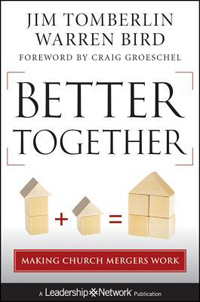
DARREN CRONSHAW on a book that’s all about merging churches…
Jim Tomberlin and Warren Bird
Better Together: Making Church Mergers Work
A Leadership Network Publication, San Francisco, Jossey-Bass, 2012
ISBN 978-1118131305
 |
“Like Peter who caught a load of fish and needed another boat to come and partner with him to capture all the blessing, churches are asking whether they can better reach their community and advance the Kingdom of God by working closer together.”
|
In past decades, church mergers were often two struggling churches hoping for survival and coming together as equals, often not being very fruitful in partnership and declining to the level of the largest of the two churches. But there is a growing trend for more vibrant partnerships forming between a strong vital church (called the “lead church”) and other churches that need fresh life and momentum (called “joining churches’).
Instead of being motivated by survival, they are called together by a vision for mission and for doing more together than they can do apart. Eighty per cent of 300,000 Protestant American churches are declining or plateaued. One per cent close each year, often not prepared for the cost of change. But two per cent of them merge annually and another five per cent have been talking about it. But how can they discern whether a merge is an appropriate step and then navigate the process?
Jim Tomberlin and Warren Bird explore the models, processes, opportunities and pitfalls of church mergers in their Leadership Network book Better Together. Tomberlin pioneered the multisite strategy at Willow Creek and founded MultiSite Solutions that consults to churches exploring multisites or mergers. Bird is the research director of Leadership Network, through which he has been doing extensive research over five years on church mergers, multisite development, revitalisation and planting.
They argue that church merging is becoming recognised as a viable revitalisation strategy for stable but stuck churches, and also strong churches who are dissatisfied with the status quo. Like Peter who caught a load of fish and needed another boat to come and partner with him to capture all the blessing, churches are asking whether they can better reach their community and advance the Kingdom of God by working closer together.
Better Together is compiled as a valuable resource and fieldbook for churches and leaders considering partnering or merging with another church. In four sections it explores the new landscape for mergers; processes of healthy church mergers; practical next steps for churches open to exploring a merger; and appendices and resources including a checklist of merger steps and case studies of successful mergers.
Drawing on broad research of what is fruitfully working, the authors outline the issues for lead churches and joining churches: how do mergers help churches grow? What is an appropriate merger process? How can churches find another church to join? What pitfalls should church mergers look out for? What happens with existing pastoral staff? Do merging churches need an exterior consultant, a vote, a name change, plans for likely conflict? The book offers advice on preparing well, initiating the conversation, assessing how the churches compare, monitoring the legal and financial aspects, and following a merger process through well – managing transitions, integrating systems, clarifying structure, avoiding overpromising, and committing to a bigger bolder vision of mission. One of the key issues is communicating thoroughly at all stages of any process, as one survey respondent suggested: “Church mergers are more like merging two family businesses. Relationships, trust, and communication are absolutely critical”.
One of the key challenges of the book is for churches to understand who they are – whether strong, stable, stuck, struggling and declining – and why they are considering merging – for survival or missional purposes, and whether with multicultural, multisite, church plant network, reconciliation or other ends in mind. The best success, the writers maintain strongly, comes to churches with clear sense of mission and a shared approach to theology and ministry practice. The best model is not the “ICU” combination of two sick churches, but either a healthy church combining with another healthy church in an equal “marriage”, or more helpfully a string church “adopting” a stuck or stable church or helping “rebirth” a struggling or dying church. A helpful question is what Steven Gray asks declining churches: “What if we were able to help you live out the vision that you were founded for in the first place, leading to an exponential impact in your community?”
The idea and even the word “merger” may carry unfortunate overtones of corporate takeover. In my Australian context we have seen few successful mergers that produce more than the sum of the parts. This volume points to the promise of new possibilities and careful processes that are worth exploring and trialling for the sake of more fruitful local mission.
Better Together is essential reading for any church leaders looking for new options or exploring possibilities of closer partnership or association with other churches, and for consultants and denominational resource-people planting ideas for the future of the church in declining contexts.
This review was originally published in Mission Studies 30 (Fall 2013), 268-269.
To buy this book, follow this link Better Together: Making Church Mergers Work.





